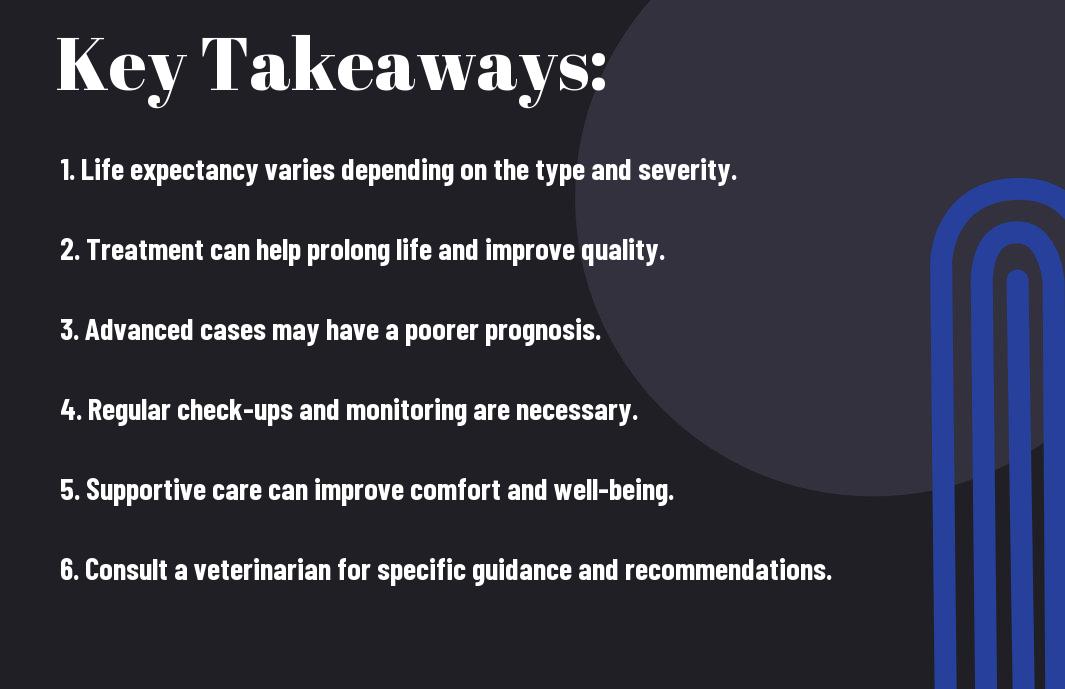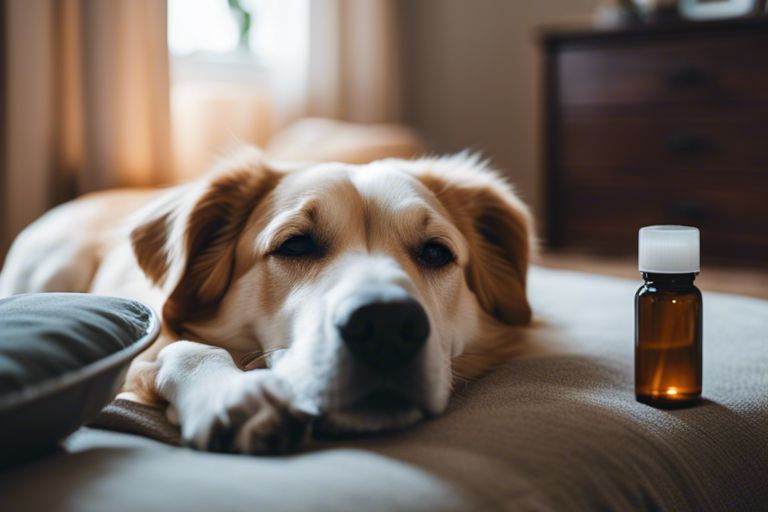Dogs with lung disease are resilient creatures, but their life expectancy can be affected by various factors. The severity of the disease, early diagnosis, and appropriate treatment all play a crucial role in determining your furry companion’s prognosis. It’s important to work closely with your veterinarian to manage your dog’s condition and provide them with the best care possible, ensuring they can live a comfortable and fulfilling life despite their lung disease.
Key Takeaways:
- Lung disease can significantly reduce a dog’s life expectancy: Dogs with lung disease may have a shorter lifespan compared to healthy dogs due to compromised respiratory function and potential complications.
- Early detection and treatment are crucial: Identifying lung disease in dogs early on and seeking appropriate veterinary care can help manage symptoms, slow disease progression, and improve the dog’s quality of life.
- Proper management and monitoring can extend a dog’s lifespan: With proper medical management, lifestyle adjustments, and regular veterinary check-ups, the life expectancy of a dog with lung disease can be prolonged, allowing them to enjoy a happy and comfortable life.
Causes of Lung Disease in Dogs
Before we examine into the life expectancy of a dog with lung disease, it is imperative to understand the various causes of lung disease in dogs. Lung diseases in dogs can be attributed to a combination of genetic predisposition, environmental factors, and respiratory infections.
Genetic Predisposition
Disease in dogs such as Bulldogs, Pugs, and other brachycephalic breeds are genetically predisposed to respiratory issues due to their flat-faced anatomy. This conformation can lead to breathing difficulties, making them more prone to developing lung diseases.
Environmental Factors
One significant environmental factor contributing to lung disease in dogs is exposure to secondhand smoke. Dogs living in households where smoking occurs are at higher risk of developing respiratory problems. Additionally, inhaling pollutants like dust, fumes, or allergens can irritate the lungs and lead to diseases.
- Exposure to air pollution.
- Presence of mold or mildew in the environment.
Though you may not have direct control over all environmental factors, ensuring your dog’s living space is clean and free of potential irritants can help reduce the risk of lung disease.
Respiratory Infections
Lung infections in dogs, such as pneumonia or kennel cough, can result in respiratory distress and damage to the lungs. These infections are often caused by viruses, bacteria, or fungi that affect the respiratory system.
Lung infections can be severe and may require veterinary treatment, including antibiotics or supportive care to help your dog recover. Therefore, it is crucial to monitor your dog for any signs of respiratory distress and seek prompt veterinary attention if needed.
Symptoms of Lung Disease in Dogs
Little is as distressing as watching your furry friend struggle with lung disease. Recognizing the symptoms can help you seek timely veterinary care and improve your dog’s quality of life.
Coughing and Wheezing
Dogs with lung disease often experience persistent coughing and wheezing. If you notice your dog having difficulty breathing or making unusual sounds while breathing, it may indicate a problem with their lungs. Consulting your veterinarian for further evaluation is crucial to determine the underlying cause and start appropriate treatment.
Shortness of Breath
To see your dog gasping for air can be a frightening experience. Shortness of breath in dogs with lung disease can manifest as rapid or labored breathing. It is imperative to monitor your dog’s breathing patterns and seek veterinary attention promptly if you notice any concerning changes.
It is important to remember that shortness of breath in dogs can be a sign of severe respiratory distress, requiring immediate medical intervention. Therefore, never delay seeking professional help if you observe any alarming symptoms in your furry companion.
Fatigue and Lethargy
Fatigue and lethargy are common symptoms seen in dogs with lung disease. Your dog may appear tired, reluctant to engage in physical activities, or seem overall less active than usual. Pay attention to these subtle changes in behavior, as they could signal an underlying respiratory issue that needs to be addressed by a veterinarian.
Fatigue in dogs with lung disease can be a result of their compromised respiratory function, as inadequate oxygen supply to the body can lead to decreased energy levels. Providing a comfortable and stress-free environment for your dog and following your vet’s recommended treatment plan can aid in managing their fatigue and improving their overall well-being.
Loss of Appetite
Wheezing
The loss of appetite in dogs with lung disease can be concerning. If you notice your dog showing disinterest in food or a significant decrease in their eating habits, it could be a sign that their respiratory condition is impacting their overall health. Consult with your veterinarian to address any appetite changes in your dog promptly.
The connection between respiration and appetite in dogs is intricate. When your dog struggles to breathe due to lung disease, it can affect their interest in food and lead to weight loss. Monitoring your dog’s food intake and collaborating closely with your vet can help manage their nutritional needs and support their recovery.
Diagnosis of Lung Disease in Dogs
Physical Examination
Once again, your veterinarian will start the diagnostic process by conducting a thorough physical examination of your dog. They will listen to your dog’s lungs for any abnormal sounds, check for signs of respiratory distress, and assess your dog’s overall health.
Imaging Tests (X-rays, CT Scans)
On top of the physical exam, imaging tests such as X-rays or CT scans may be recommended to get a detailed look at your dog’s lungs. These tests can help identify any abnormalities, such as inflammation, fluid build-up, or masses in the lungs.
The imaging tests are non-invasive procedures that provide valuable information about the condition of your dog’s lungs. Your veterinarian will interpret the results to determine the appropriate course of treatment for your furry friend.
Laboratory Tests (Blood Work, Biopsy)
Tests such as blood work and biopsies may also be conducted to further investigate lung disease in your dog. Blood work can reveal potential infections or inflammation, while a biopsy involves taking a small sample of lung tissue for analysis.
It is important to follow your veterinarian’s recommendations for diagnostic tests to accurately diagnose your dog’s lung disease. These tests play a crucial role in determining the most effective treatment plan for your beloved pet.
Treatment Options for Dogs with Lung Disease
Noticing that your beloved dog is struggling to breathe can be distressing. Fortunately, there are various treatment options available to help manage lung disease in dogs and improve their quality of life. These treatments aim to reduce inflammation, open airways, and provide the necessary support to help your furry companion breathe easier.
Medications (Bronchodilators, Anti-Inflammatories)
Treatment with medications such as bronchodilators and anti-inflammatories can help alleviate symptoms of lung disease in dogs. Bronchodilators work by relaxing the muscles around the airways, making it easier for your dog to breathe. Anti-inflammatories help reduce inflammation in the airways, improving airflow and reducing discomfort for your pet.
Oxygen Therapy
Dogs with severe lung disease may benefit from oxygen therapy, which involves providing supplemental oxygen to help your dog breathe more comfortably. Oxygen therapy can be administered through a mask or nasal cannula to ensure your pet receives the oxygen they need to support their respiratory function.
It is vital to work closely with your veterinarian to determine the appropriate oxygen therapy regimen for your dog. Monitoring your pet’s response to treatment and making any necessary adjustments will help ensure they receive the best care possible.
Lifestyle Changes (Diet, Exercise)
On top of medical interventions, making lifestyle changes can also play a crucial role in managing lung disease in dogs. A well-balanced diet can support your dog’s overall health and immune system, while regular, moderate exercise can help maintain their respiratory function and improve their quality of life.
With the right combination of medication, oxygen therapy, and lifestyle adjustments, you can help your furry friend manage lung disease effectively and enjoy a happier, healthier life by your side.
Factors Affecting Life Expectancy
All dog’s with lung disease are unique, and several factors can affect their life expectancy. Below are some key factors to consider:
Severity of Disease
Life expectancy can be greatly influenced by the severity of the lung disease. Dogs with mild cases may live a longer and more comfortable life compared to those with advanced stages of the disease. Regular check-ups with your veterinarian can help monitor the progression of the illness.
Age and Breed of Dog
On average, smaller dog breeds tend to live longer than larger breeds. Additionally, younger dogs usually have a better prognosis when dealing with lung disease. Older dogs may have weaker immune systems and may struggle more with respiratory issues.
Breed can also play a significant role in life expectancy. Some breeds are genetically predisposed to certain respiratory conditions, which can impact how they respond to treatment and manage their symptoms.
Quality of Care and Treatment
Treatment for lung disease in dogs can vary depending on the specific condition and its severity. Following your veterinarian’s treatment plan diligently and ensuring your pet receives proper care can significantly impact their quality of life and life expectancy.
Understanding the importance of early detection, regular veterinary visits, and compliance with treatment recommendations can help improve your dog’s prognosis and overall well-being.
Managing Lung Disease in Dogs
After learning about lung disease in dogs, it’s vital to manage the condition effectively to ensure your furry companion’s well-being. Monitoring your dog’s progress is crucial in managing lung disease. Regular check-ups with your veterinarian are necessary to track the disease’s advancement and adjust treatment plans as needed. You can also keep an eye out for any changes in your dog’s breathing patterns, energy levels, or appetite that may indicate progression of the condition. For more information on managing bronchitis in dogs, you can check out this resource on Bronchitis In Dogs: Symptoms & Treatments.
Monitoring Progress
On your journey to manage your dog’s lung disease, monitoring progress is key. By observing any changes in your dog’s behavior, appetite, or exercise tolerance, you can relay crucial information to your veterinarian. They can then tailor treatment plans to suit your dog’s specific needs, helping to maintain their quality of life.
Adapting to Changes
An important aspect of managing lung disease in dogs is adapting to changes in your dog’s lifestyle and environment. This may involve modifying their exercise routine, ensuring they have access to clean air, or making adjustments to their diet. By being flexible and proactive in adapting to these changes, you can help your dog live comfortably with their condition.
Changes in your dog’s breathing, energy levels, or overall health may require you to make further adaptations to their care. It’s vital to stay in close communication with your veterinarian to address any new developments promptly and make necessary adjustments to your dog’s management plan.
Providing Emotional Support
Dogs with lung disease may experience anxiety or stress due to their condition. Providing emotional support is just as important as managing the physical aspects of their care. You can offer comfort through your presence, create a relaxing environment, and engage in calming activities that your dog enjoys. Additionally, keeping a routine and offering lots of love and attention can help your dog feel safe and secure during this challenging time.
Plus, staying positive and maintaining a strong bond with your furry friend can make a significant difference in their overall well-being. By being there for them every step of the way, you can help your dog navigate their lung disease with comfort and companionship.
Conclusion
Considering all points discussed in this article, the life expectancy of a dog with lung disease can vary depending on the specific condition, the severity of the disease, and the overall health status of the dog. With proper veterinary care, medications, and lifestyle adjustments, you can help improve your dog’s quality of life and potentially extend their lifespan. It is crucial to work closely with your veterinarian to develop a treatment plan tailored to your dog’s individual needs and to monitor their condition regularly.
Bear in mind, every dog is unique, and the prognosis for each case of lung disease can differ. By staying informed, proactive, and providing attentive care for your furry companion, you can help manage their condition and ensure they have the best possible chance at a longer and healthier life.
FAQ
Q: What is the life expectancy of a dog with lung disease?
A: The life expectancy of a dog with lung disease can vary depending on the specific type and severity of the condition. It is important to work closely with your veterinarian to determine the prognosis and treatment options for your furry companion.
Q: What are the common symptoms of lung disease in dogs?
A: Common symptoms of lung disease in dogs may include coughing, difficulty breathing, wheezing, lethargy, and exercise intolerance. If you notice any of these signs, it is imperative to seek veterinary care promptly.
Q: How is lung disease diagnosed in dogs?
A: Lung disease in dogs can be diagnosed through a combination of physical examination, diagnostic imaging (such as X-rays or CT scans), blood tests, and in some cases, a biopsy of the lung tissue. Your veterinarian will determine the appropriate diagnostic tests based on your dog’s symptoms and medical history.
Q: What are the treatment options for lung disease in dogs?
A: Treatment for lung disease in dogs may include medications (such as bronchodilators or antibiotics), oxygen therapy, dietary changes, and management of underlying conditions. In some cases, surgery may be necessary. Your veterinarian will tailor a treatment plan specific to your dog’s needs.
Q: How can I support a dog with lung disease?
A: To support a dog with lung disease, it is important to follow your veterinarian’s recommendations for medication administration, monitor your dog for any changes in symptoms, provide a comfortable and stress-free environment, and maintain regular veterinary check-ups. Additionally, avoiding exposure to smoke, pollutants, and other respiratory irritants can help improve your dog’s quality of life.
Are strawberries toxic for dogs
Your Dog’s Allergies: Expert Advice
Demystifying Anal Gland Issues in Dogs: Your Comprehensive Guide from the American Kennel Club




